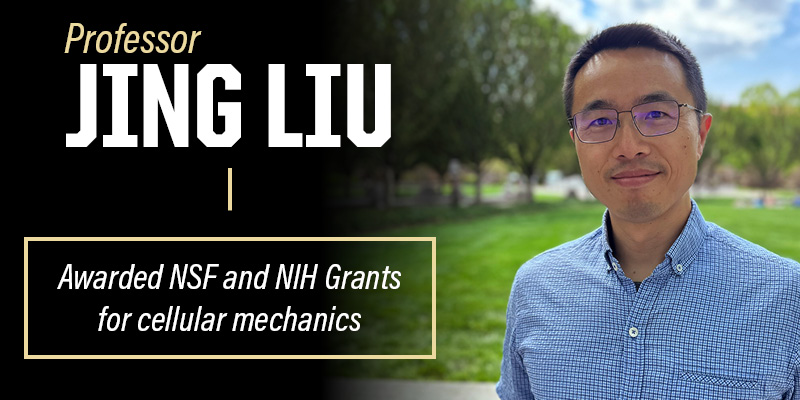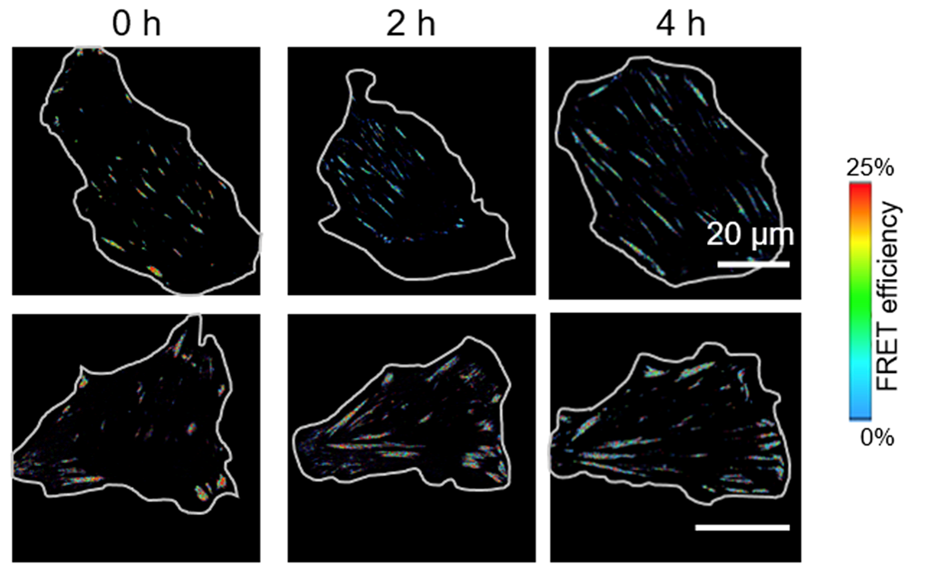Jing Liu awarded NSF and NIH grants to study mechanics in human cells
2024-05-02

Human cells generate and sustain mechanical forces as part of their normal physiology. These forces, typically in the scale of several to tens of piconewton (10-12 N), could easily control the structures and biological functions of the cell. A newton is a unit used to measure force and a piconewton is one trillionth of a newton. Detecting forces in this scale is really challenging, particularly in a live human cell. Jing Liu, associate professor at the Purdue Department of Physics and Astronomy, has integrated modern molecular biology techniques with imaging methods to detect the piconewton forces generated inside a living cell.
“This precise measurement was enabled by a molecular biosensor based on the Forster resonance energy transfer (FRET)” says Liu. “This tension sensor was purified from the spider silk protein and is about 15 nm long; it acts as an entropic spring to report the bearing forces produced by the cell. Our lab has collaborated with molecular biologists to insert this tension sensor into different motor proteins inside the cell to measure the mechanics in cell focal adhesion that is important for cell migration, and in cell membrane and skeleton that are critical for cell architectures.”
Liu’s lab is collaborating in cutting-edge mechanics-driven biophysics and medical research which has recently gained him two grants to study cell migration and cells in the human eye.
One of the two grants awarded to Liu is a joint National Science Foundation (NSF) and National Institute of Health (NIH) grant titled “DMS/NIGMS 1: Simulating cell migration with a multi-scale 3D model fed by intracellular tension sensing measurements.” This three-year $600,000 collaborative grant with be used by Jared Barber , associate professor of mathematical sciences at IUPUI, and Liu. The two will combine live-cell force sensing with mathematical models to understand how internal forces of a cell respond to the properties of the surrounding, external environment and drive cell migration. The outcome, in turn, will lead to a better understanding of how to inhibit (such as with cancer) or promote (such as with healing wounds) cell migration to improve patient outcomes.
The second of Liu’s grant awards will come from the NIH R01 grant (1R01EY035412) which is titled, “Transcriptional control of lipid biogenesis in trabecular meshwork and intraocular pressure regulation.” This is a collaborative four-year grant for $1.8M. This grant is funded by the National Eye Institute to support a collaborative team with researchers from IU School of Medicine, Purdue, and UIUC. Padmanabhan Pattabiraman, assistant professor from the Indiana University School of Medicine, is the principal investigator for this grant and will lead the multidisciplinary team to investigate the molecular mechanism of glaucoma.
“For the NIH R01 grant, my team will apply the imaging-based force sensing approach to assess the real-time changes in membrane tension of trabecular meshwork cells upon the protein activation/inhibition," says Liu. "This will help us to understand the mechano-regulation of the trabecular meshwork cells."
“Multidisciplinary approaches that integrate modern molecular biology techniques, advanced force sensing methods, and mathematical modeling now pave the way towards better understanding the role of mechanics in disease initiation, development biology, and physiology,” added Liu. “There is significant overlap between physics and biological sciences, and this collaborative scientific approach would lead to giant leaps in medical advances.”

About the Department of Physics and Astronomy at Purdue University
Purdue’s Department of Physics and Astronomy has a rich and long history dating back to 1904. Our faculty and students are exploring nature at all length scales, from the subatomic to the macroscopic and everything in between. With an excellent and diverse community of faculty, postdocs and students who are pushing new scientific frontiers, we offer a dynamic learning environment, an inclusive research community and an engaging network of scholars.
Physics and Astronomy is one of the seven departments within the Purdue University College of Science. World-class research is performed in astrophysics, atomic and molecular optics, accelerator mass spectrometry, biophysics, condensed matter physics, quantum information science, and particle and nuclear physics. Our state-of-the-art facilities are in the Physics Building, but our researchers also engage in interdisciplinary work at Discovery Park District at Purdue, particularly the Birck Nanotechnology Center and the Bindley Bioscience Center. We also participate in global research including at the Large Hadron Collider at CERN, many national laboratories (such as Argonne National Laboratory, Brookhaven National Laboratory, Fermilab, Oak Ridge National Laboratory, the Stanford Linear Accelerator, etc.), the James Webb Space Telescope, and several observatories around the world.
About Purdue University
Purdue University is a public research institution demonstrating excellence at scale. Ranked among top 10 public universities and with two colleges in the top four in the United States, Purdue discovers and disseminates knowledge with a quality and at a scale second to none. More than 105,000 students study at Purdue across modalities and locations, including nearly 50,000 in person on the West Lafayette campus. Committed to affordability and accessibility, Purdue’s main campus has frozen tuition 13 years in a row. See how Purdue never stops in the persistent pursuit of the next giant leap — including its first comprehensive urban campus in Indianapolis, the new Mitchell E. Daniels, Jr. School of Business, and Purdue Computes — at https://www.purdue.edu/president/strategic-initiatives.
Contributors:
Jing Liu, associate professor in the Department of Physics and Astronomy at Purdue University
Written by Cheryl Pierce, Communications Specialist